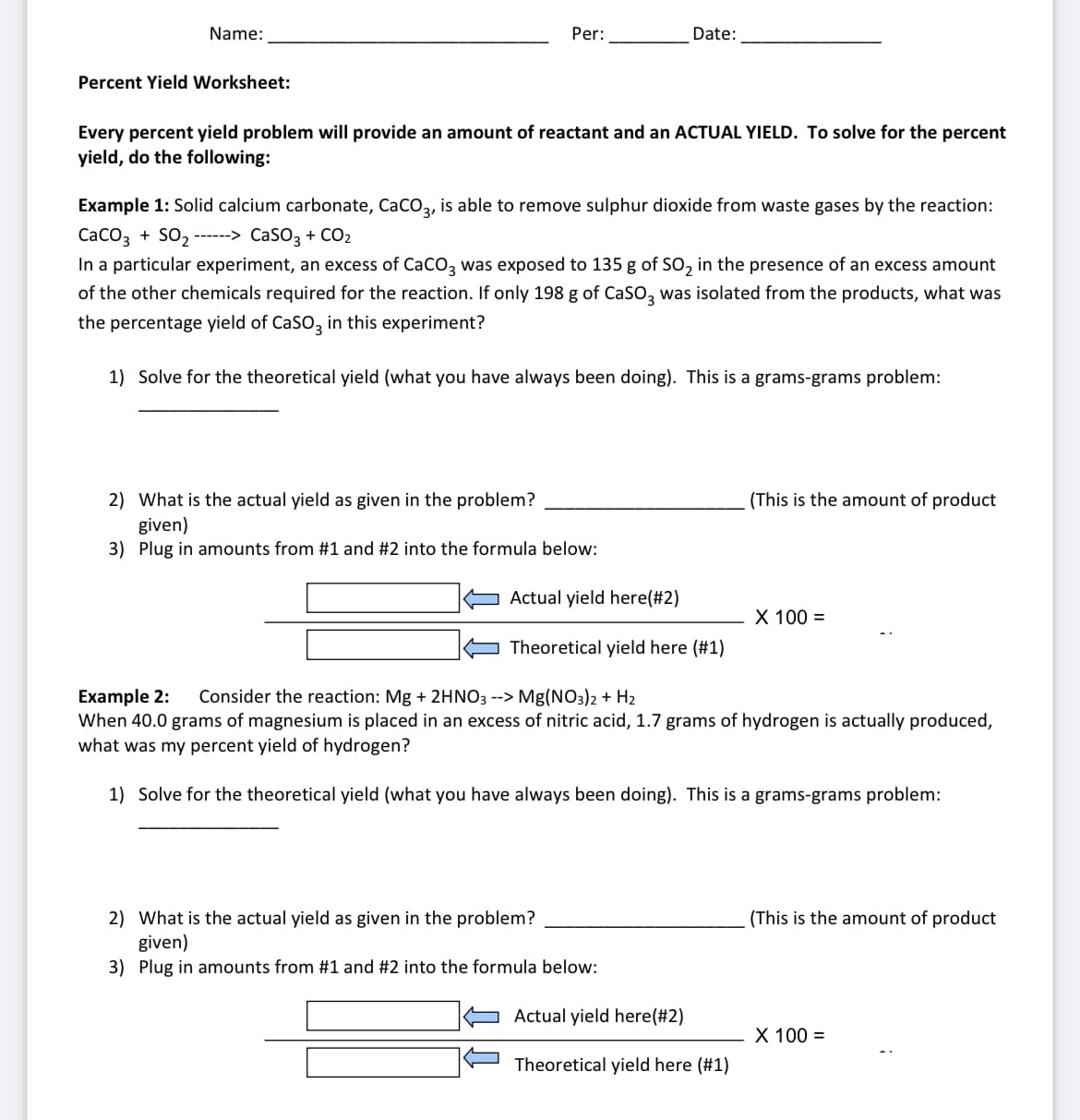Example 1: Solid calcium carbonate, CaCO,, is able to remove sulphur dioxide from waste gases by the reaction: CaCO3 + SO2 ------> CaSO3 + CO2 In a particular experiment, an excess of CaCO3 was exposed to 135 g of SO2 in the presence of an excess amount of the other chemicals required for the reaction. If only 198 g of CaSO, was isolated from the products, what was the percentage yield of CaSO, in this experiment? 1) Solve for the theoretical yield (what you have always been doing). This is a grams-grams problem: 2) What is the actual yield as given in the problem? given) 3) Plug in amounts from #1 and #2 into the formula below: (This is the amount of product Actual yield here(#2) X 100 = Theoretical yield here (#1)
Example 1: Solid calcium carbonate, CaCO,, is able to remove sulphur dioxide from waste gases by the reaction: CaCO3 + SO2 ------> CaSO3 + CO2 In a particular experiment, an excess of CaCO3 was exposed to 135 g of SO2 in the presence of an excess amount of the other chemicals required for the reaction. If only 198 g of CaSO, was isolated from the products, what was the percentage yield of CaSO, in this experiment? 1) Solve for the theoretical yield (what you have always been doing). This is a grams-grams problem: 2) What is the actual yield as given in the problem? given) 3) Plug in amounts from #1 and #2 into the formula below: (This is the amount of product Actual yield here(#2) X 100 = Theoretical yield here (#1)
Chemistry: Principles and Reactions
8th Edition
ISBN:9781305079373
Author:William L. Masterton, Cecile N. Hurley
Publisher:William L. Masterton, Cecile N. Hurley
Chapter3: Mass Relations In Chemistry; Stoichiometry
Section: Chapter Questions
Problem 66QAP: Chlorine and fluorine react to form gaseous chlorine trifluoride. Initially, 1.75 mol of chlorine...
Related questions
Question
Could you please complete this worksheet on a separate sheet of paper showing work as well as answering the questions?

Transcribed Image Text:Name:
Per:
Date:
Percent Yield Worksheet:
Every percent yield problem will provide an amount of reactant and an ACTUAL YIELD. To solve for the percent
yield, do the following:
Example 1: Solid calcium carbonate, CaCO3,
is able to remove sulphur dioxide from waste gases by the reaction:
CaCO3 + SO2 ------> CaSO3 + CO2
In a particular experiment, an excess of CaCO3 was exposed to 135 g of SO, in the presence of an excess amount
of the other chemicals required for the reaction. If only 198 g of CaSO3
was isolated from the products, what was
the percentage yield of CaSO, in this experiment?
1) Solve for the theoretical yield (what you have always been doing). This is a grams-grams problem:
(This is the amount of product
2) What is the actual yield as given in the problem?
given)
3) Plug in amounts from #1 and #2 into the formula below:
Actual yield here(#2)
X 100 =
Theoretical yield here (#1)
Consider the reaction: Mg + 2HNO3 --> Mg(NO3)2 + H2
Example 2:
When 40.0 grams of magnesium is placed in an excess of nitric acid, 1.7 grams of hydrogen is actually produced,
what was my percent yield of hydrogen?
1) Solve for the theoretical yield (what you have always been doing). This is a grams-grams problem:
2) What is the actual yield as given in the problem?
given)
3) Plug in amounts from #1 and #2 into the formula below:
(This is the amount of product
Actual yield here(#2)
X 100 =
Theoretical yield here (#1)
Expert Solution
This question has been solved!
Explore an expertly crafted, step-by-step solution for a thorough understanding of key concepts.
This is a popular solution!
Trending now
This is a popular solution!
Step by step
Solved in 3 steps

Knowledge Booster
Learn more about
Need a deep-dive on the concept behind this application? Look no further. Learn more about this topic, chemistry and related others by exploring similar questions and additional content below.Recommended textbooks for you

Chemistry: Principles and Reactions
Chemistry
ISBN:
9781305079373
Author:
William L. Masterton, Cecile N. Hurley
Publisher:
Cengage Learning

Introductory Chemistry: A Foundation
Chemistry
ISBN:
9781337399425
Author:
Steven S. Zumdahl, Donald J. DeCoste
Publisher:
Cengage Learning

Chemistry: Matter and Change
Chemistry
ISBN:
9780078746376
Author:
Dinah Zike, Laurel Dingrando, Nicholas Hainen, Cheryl Wistrom
Publisher:
Glencoe/McGraw-Hill School Pub Co

Chemistry: Principles and Reactions
Chemistry
ISBN:
9781305079373
Author:
William L. Masterton, Cecile N. Hurley
Publisher:
Cengage Learning

Introductory Chemistry: A Foundation
Chemistry
ISBN:
9781337399425
Author:
Steven S. Zumdahl, Donald J. DeCoste
Publisher:
Cengage Learning

Chemistry: Matter and Change
Chemistry
ISBN:
9780078746376
Author:
Dinah Zike, Laurel Dingrando, Nicholas Hainen, Cheryl Wistrom
Publisher:
Glencoe/McGraw-Hill School Pub Co

Introductory Chemistry: An Active Learning Approa…
Chemistry
ISBN:
9781305079250
Author:
Mark S. Cracolice, Ed Peters
Publisher:
Cengage Learning

World of Chemistry
Chemistry
ISBN:
9780618562763
Author:
Steven S. Zumdahl
Publisher:
Houghton Mifflin College Div

Chemistry by OpenStax (2015-05-04)
Chemistry
ISBN:
9781938168390
Author:
Klaus Theopold, Richard H Langley, Paul Flowers, William R. Robinson, Mark Blaser
Publisher:
OpenStax